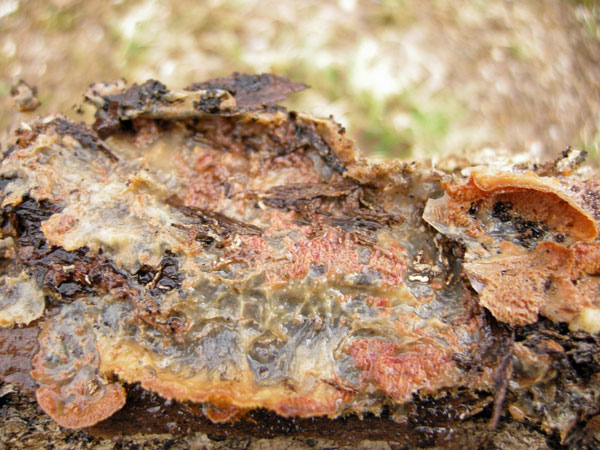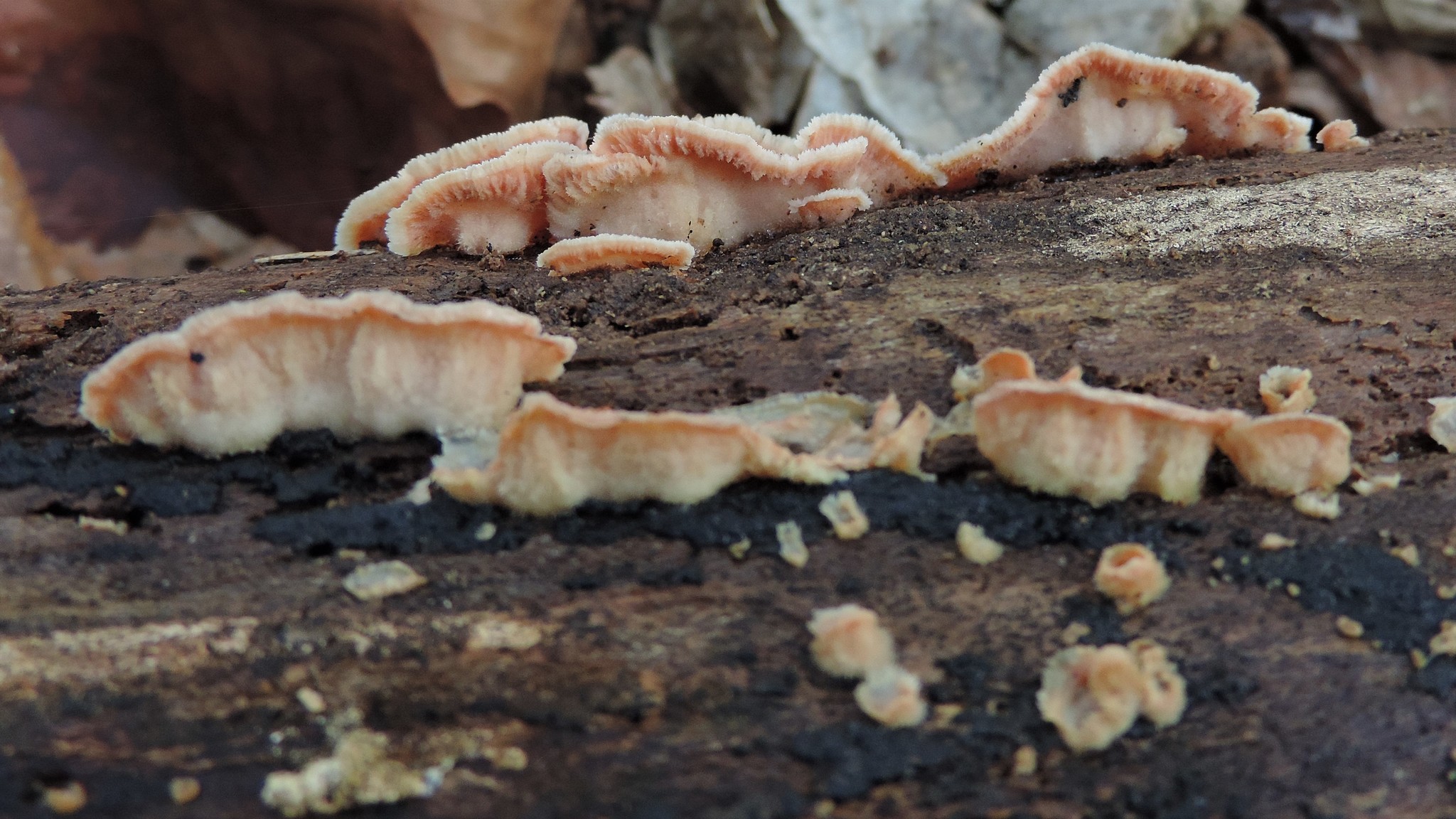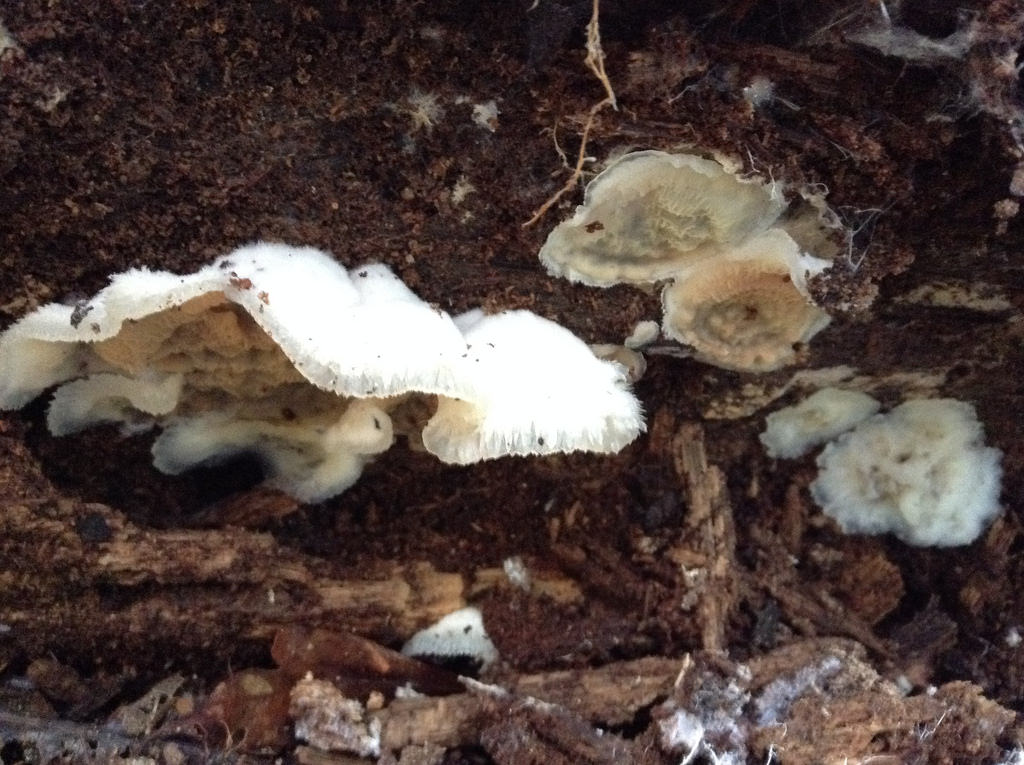Map Snapshot























141 Records
Description
Fruiting body: Small bodies usually fused; white/pale yellow, hairy; margin curves outward to form a bracket; flesh white to pink, waxy or gelantinous. Fertile suface: Pinkish-orange to brownish-salmon; wrinkled or ribbed (J. Solem, pers. comm.).
Where To Find
Often overlapping clusters usually on hardwoods, occasionally on conifers (J. Solem, pers. comm.).
Seasonality Snapshot
Source: Wikipedia
| Phlebia tremellosa | |
|---|---|

| |
| Scientific classification | |
| Domain: | Eukaryota |
| Kingdom: | Fungi |
| Division: | Basidiomycota |
| Class: | Agaricomycetes |
| Order: | Polyporales |
| Family: | Meruliaceae |
| Genus: | Phlebia |
| Species: | P. tremellosa
|
| Binomial name | |
| Phlebia tremellosa (Schrad.) Nakasone & Burds. (1984)
| |
| Synonyms[1] | |
| |
Phlebia tremellosa (formerly Merulius tremellosus), commonly known as trembling Merulius or jelly rot, is a species of fungus in the family Meruliaceae. It is a common and widely distributed wood-decay fungus that grows on the rotting wood of both hardwood and conifer plants.
Taxonomy
[edit]The fungus was originally described in 1794 by German botanist Heinrich Adolf Schrader, who called it Merulius tremellosus.[2] Nakasone and Burdsall transferred the taxon to the genus Phlebia in 1984, when they placed Merulius in synonymy.[3]
It is commonly known as the "trembling Merulius",[4] or "jelly rot".[5]
Description
[edit]Fruit bodies of the fungus are fan-shaped to semicircular, measuring 2–4 cm (3⁄4–1+5⁄8 in) wide by 5–10 cm (2–3+7⁄8 in) long. They have a spongy to fibrous texture, comprising stalkless caps or spreading crusts. The upper surface, white to pale yellow in colour, can be dry to moist, and hairy to woolly; the margin is usually white to translucent.[6] The undersurface, bearing the fertile hymenium, features radiating to wrinkled ridges and cross veins, and often forms pore-like depressions on mature specimens. Its colour is yellowish orange or pinkish orange. The flesh of this fungus is about 2 mm thick, with a fleshy to gelatinous texture and white to yellowish colour.[4]
In Dutch, the mushroom is known as bacon-pork rind mushroom because of the resembling with a piece of bacon.[7] It is inedible.[8]
-
The spore-bearing surface features wrinkled ridges and cross veins.
-
Phlebia tremellosa resembling a piece of bacon
Habitat and distribution
[edit]Phlebia tremellosa is found in Asia, Europe, North Africa, North America, and South America. It is a white rot species that grows on the stumps, fallen branches, and logs of both hardwoods and conifers.[5]
References
[edit]- ^ "GSD Species Synonymy: Phlebia tremellosa (Schrad.) Nakasone & Burds". Species Fungorum. Kew Mycology. Retrieved 2018-04-12.
- ^ Schrader, H.A. (1794). Spicilegium Florae Germanicae (in Latin). Hanover: Impensis C. Ritsdheri. p. 139.
- ^ Nakasone, K.K.; Burdsall Jr, H.H. (1984). "Merulius, a synonym of Phlebia". Mycotaxon. 21: 241–246.
- ^ a b Bessette, A.E.; Roody, W.C.; Bessette, A.R. (2007). Mushrooms of the Southeastern United States. Syracuse: Syracuse University Press. p. 329. ISBN 978-0815631125.
- ^ a b Roberts, P.; Evans, S. (2011). The Book of Fungi. Chicago, Illinois: University of Chicago Press. p. 428. ISBN 978-0-226-72117-0.
- ^ Trudell, Steve; Ammirati, Joe (2009). Mushrooms of the Pacific Northwest. Timber Press Field Guides. Portland, OR: Timber Press. p. 266. ISBN 978-0-88192-935-5.
- ^ "Boter en spekzwoerd". www.heijen.info.
- ^ Miller Jr., Orson K.; Miller, Hope H. (2006). North American Mushrooms: A Field Guide to Edible and Inedible Fungi. Guilford, CN: FalconGuides. p. 434. ISBN 978-0-7627-3109-1.
External links
[edit]![]() Media related to Merulius tremellosus at Wikimedia Commons
Media related to Merulius tremellosus at Wikimedia Commons































